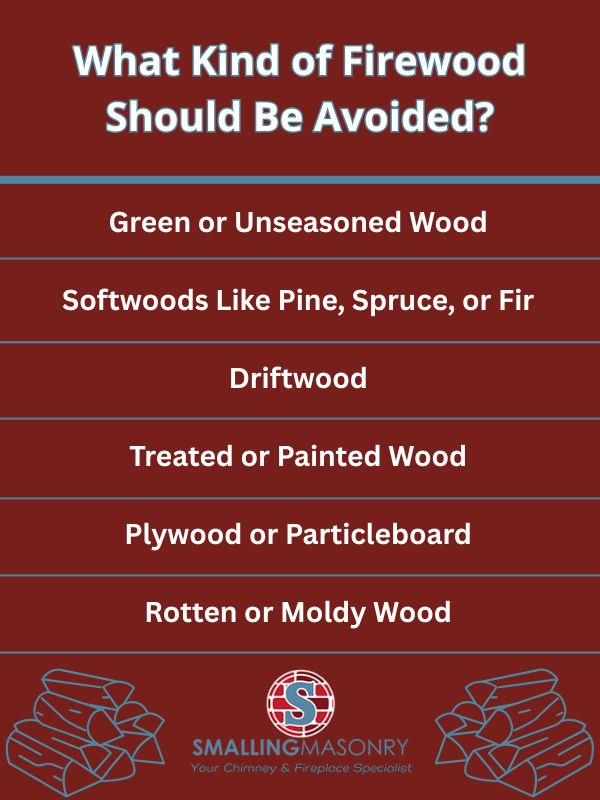And if you haven’t booked your annual chimney inspection and cleaning, give Smalling Masonry a call now or reach out to us online!
Is Softwood or Hardwood Better for My Fireplace?
When it comes to deciding between softwood and hardwood, hardwood is the clear winner for a fireplace. The difference lies in density. Hardwood is denser and contains more stored energy. This means that when it burns, it produces a hotter, longer-lasting fire with less smoke and fewer sparks. This steady heat output makes hardwood especially useful in the colder months, when fireplaces are relied upon for consistent warmth.
Softwoods, like pine, spruce, and fir, ignite quickly and may seem appealing for starting a fire, but they burn much faster and don’t provide the same sustained heat. They also tend to produce more creosote, the flammable byproduct of wood combustion that clings to the walls of your chimney. While softwood can sometimes be used for kindling to get a fire going, it should not be relied upon as your primary firewood source.
Using seasoned hardwood instead of softwood is not only better for your comfort, but it also helps reduce the amount of creosote buildup inside your chimney, lowering the risk of chimney problems during peak burning season.
Which Hardwoods Are the Best To Burn?
There are many different hardwoods available, but some perform better than others. When shopping for firewood this winter, consider these top hardwood options:
- Oak. A classic choice, oak is dense, long-burning, and widely available. It requires a longer seasoning period but rewards with steady, high heat.
- Hickory. Known for its exceptional heat output, hickory burns hotter than most hardwoods and has a pleasant aroma. It’s often considered one of the best woods for heating.
- Maple. With moderate density, maple provides good heat and burns cleanly. It’s also relatively easy to split and handle.
- Ash. Unique among hardwoods, ash can be burned even when it’s not fully seasoned. It lights easily, produces steady heat, and leaves behind minimal ash.
- Beech. Another excellent option, beech burns hot and long, though it needs to be well-seasoned to perform at its best.
- Cherry. While it doesn’t burn as hot as oak or hickory, cherry has a pleasant fragrance and provides steady, reliable heat, making it a good choice for ambiance fires.
The key to getting the best performance out of any hardwood is proper seasoning. Firewood should be split, stacked, and allowed to dry for at least six to 12 months before burning. Well-seasoned wood has a moisture content of 20% or less, which ensures cleaner combustion, less creosote, and more efficient heating.
What Kind of Firewood Should I Avoid Burning?
Not all firewood is suitable for your fireplace. Some types of wood can cause excessive creosote buildup, damage your system, or release harmful chemicals. Here are some you should steer clear of:
- Green or unseasoned wood. Freshly cut wood contains high levels of moisture. Burning it produces a lot of smoke, low heat, and rapid creosote buildup.
- Softwoods like pine, spruce, or fir. While okay in small amounts for kindling, these woods burn too quickly and contribute to creosote accumulation when used as primary firewood.
- Driftwood. Wood that’s been exposed to saltwater releases corrosive chemicals when burned, which can damage your fireplace and chimney components.
- Treated or painted wood. Any wood that’s been chemically treated, stained, or painted should never be burned indoors. Combustion releases toxic fumes that are harmful to inhale.
- Plywood or particleboard. Manufactured woods contain glues, adhesives, and other chemicals that can release hazardous emissions when burned.
- Rotten or moldy wood. Decomposed wood doesn’t burn well and can release spores and unpleasant odors into your home.

Choosing the right wood is about more than just enjoying a cozy fire. It directly impacts your fireplace’s efficiency, the cleanliness of your chimney, and the air quality inside your home.
Keep Your Fireplace Ready With Smalling Masonry
Burning the right firewood is only one piece of keeping your fireplace in top condition this winter. Regular chimney maintenance and inspections are just as important for preventing issues and ensuring your system works efficiently all season long. Smalling Masonry provides professional chimney sweeping, inspections, and repair services throughout Indianapolis to help homeowners enjoy their fireplaces with confidence. Click here or call today to schedule your appointment before the burning season is in full swing.
